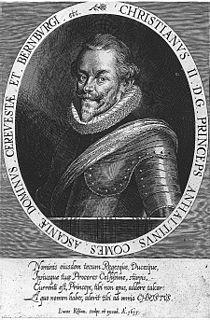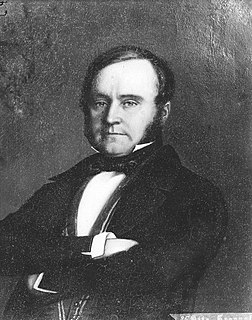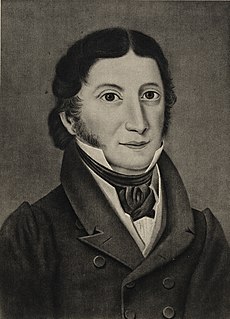Related Research Articles

Charles Merivale was an English historian and churchman, for many years dean of Ely Cathedral. He was one of the main instigators of the inaugural Oxford and Cambridge Boat Race which took place at Henley in 1829.

Charles Anthon was an American classical scholar.
The Synod of the Norwegian Evangelical Lutheran Church in America, commonly called the Norwegian Synod, was founded in 1853. It included churches in Illinois, Iowa, Minnesota, and Wisconsin.

Christian I, Prince of Anhalt-Bernburg, also known as Christian of Anhalt, was a German prince of the House of Ascania. He was ruling prince of Anhalt and, from 1603, ruling prince of the revived principality of Anhalt-Bernburg. From 1595 he was governor of Upper Palatinate, and soon became the advisor-in-chief of Frederick IV, Elector Palatine.

Peter Andreas Blix was a Norwegian architect and engineer best known for designing railway stations and villas in Swiss chalet style. He was also occupied with the conservation of Norwegian stave churches and the construction of canals in 19th century Norway.

The Norwegian Lutheran Church in the United States is a general term to describe the Lutheran church tradition developed within the United States by immigrants from Norway.

A scholarch was the head of a school in ancient Greece. The term is especially remembered for its use to mean the heads of schools of philosophy, such as the Platonic Academy in ancient Athens. Its first scholarch was Plato himself, the founder and proprietor. He held the position for forty years, appointing his nephew Speusippus as his successor. The members of the Academy elected later scholarchs.

Herman Bagger was a Norwegian newspaper editor and politician.
Johan Lauritz Walbom Amberg was a Danish composer and violinist.
Herman Amberg was a Danish musician and composer.

Jacob Liv Borch Sverdrup was a Norwegian educator and farmer, known for establishing the first agricultural school in Scandinavia.

Herman Amberg Preus was an American Lutheran clergyman and church leader. Ordained in 1848, he became a key figure in organizing the Norwegian Synod.
Hans Christian Amberg, sometimes H. C. Amberg was a Danish lexicographer.

Marius Nygaard was a Norwegian educator and linguist.

Johan Peter Weisse was a Norwegian philologist.

Jørgen Hansen Koch was a Neoclassical Danish architect. He was chief of the national Danish building administration from 1835 and director of the Royal Danish Academy of Fine Arts from 1844 to 1849.

Hans Christian Amberg was a Danish architect.
Sir Peter Paulson Paus, also rendered as Peder Povelsson Paus, was a Norwegian high-ranking cleric who served as the provost of Upper Telemark from 1633 until his death. He is known through a loving poem in Latin written by his son Paul Peterson Paus in his memory in 1653, In memoriam Domini Petri Pavli. His descendants include the playwright Henrik Ibsen.
Amberg is a Bavarian, Austrian and Swiss German toponymic surname, and it originated in Bavaria after the city Amberg, but can come from any of several places named Amberg. It may refer to:

Johannes Dam Hage was founder and editor-in-chief of the Danish republican journal Fædrelandet which had a decisive influence on the establishment in Denmark of a constitutional monarchy.
References
- ↑ Kraft, Jens Edvard (1863). "15 (Norsk Forfatter-Lexicon 1814-1856)". runeberg.org (in Norwegian). Retrieved 2020-01-23.
- 1 2 3 Thrap, D. (1887). "Amberg, Herman". In Bricka, Carl Frederik (ed.). Dansk biografisk lexikon (in Danish). 1. Copenhagen: Gyldendalske Boghandels Forlag. pp. 193–194. Retrieved 7 November 2009.
- ↑ List of publications in BIBSYS